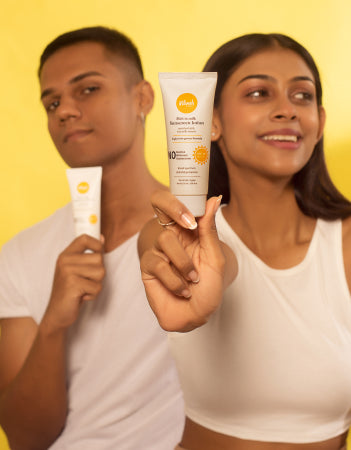As you soak up the sun's warmth, it's easy to forget that its rays carry life-giving energy and potential harm. That's where sunscreen steps in as a silent guardian, shielding your skin from the sun's powerful ultraviolet (UV) radiation. But how exactly does it work? In this blog post, you will learn about the science behind your favourite SPF product, sunscreen. Whether you enjoy hiking or spending time at home, this knowledge will empower you to make sun protection an integral part of your daily routine.
Why sunscreen?
Sunscreen, in its essence, is a skin care product that acts as a barrier between your skin and the sun's harmful UV rays. It contains specially formulated ingredients that work together to absorb, reflect, or scatter the UV radiation, preventing it from penetrating the skin.
The science behind sunscreen
Hybrid sunscreen, as the name suggests, combines the benefits of both chemical and physical sunscreens. This innovative formulation offers a broader spectrum of protection, effectively shielding your skin from UVA and UVB rays. It's like having a double layer of defence, ensuring that you're safeguarded from the harshest elements of sunlight.
Understanding SPF
SPF, or Sun Protection Factor, is a measure of how effectively a sunscreen protects against UVB rays, which are primarily responsible for sunburn and skin cancer. Hybrid sunscreens boast varying levels of Sun Protection Factor (SPF), indicating their ability to protect against UV rays. The higher the SPF, the greater the protection.
- SPF 30: Filters out about 97% of UV rays.
- SPF 50: Filters out about 98% of UV rays.
Best UV protection
Hybrid sunscreen contains a blend of active ingredients that work together synergistically. This combination enhances the overall effectiveness of the sunscreen and extends the duration of protection. With hybrid sunscreen SPF50, you can confidently enjoy extended hours under the sun without worrying about constant reapplication.
Suitable for all skin types
One of the common concerns with sunscreens, especially chemical ones, is skin sensitivity. Some individuals may experience irritation or allergic reactions. Hybrid sunscreen like Melt-in-Milk Sunscreen SPF 30 addresses this issue by utilizing advanced formulations that are gentle on the skin. It's suitable for all skin types, made using the goodness of soy milk extract and safe UV filters, making it an excellent choice for individuals with sensitive skin.
Non-greasy, lightweight formula
One of the main gripes people have with sunscreen while shopping for face care products is its texture. Traditional sunscreens can feel heavy, greasy, and uncomfortable on the skin. Hybrid sunscreen, on the other hand, boasts a lightweight, non-greasy formula that absorbs effortlessly. This means you can enjoy superior protection without feeling like you're wearing a heavy mask.
Transparency
Nobody wants to walk around with a white cast on their skin. Hybrid Sunscreen Combo offers a transparent finish, blending seamlessly with your natural skin tone. This means it can easily be incorporated into your daily skincare routine, whether you're heading to the beach or just running around town.
Water-resistant sunscreen
Hybrid sunscreen's water-resistant properties make it an ideal choice for those who love spending time in the water. Whether you're swimming, surfing, or simply lounging by the pool, you can trust that your skin will stay protected throughout your aquatic adventures.
Acne-free formula
Acne-Free formula sunscreen is a breakthrough in skincare designed to provide superior sun protection without compromising on acne-prone skin concerns. Enriched with non-comedogenic ingredients, it helps defend against sun damage and helps maintain clear and blemish-free skin. The lightweight and oil-free texture makes it an ideal choice for daily use, seamlessly integrating into your skincare routine without clogging pores.
Sunscreen application: An even coverage
Start by gently applying it on all of your skin. Be sure to pay special attention to commonly overlooked areas like the ears, neck, and tops of feet. Always remember that it's preferable to apply more than you need. A thin layer of sunscreen won't offer sufficient defence.


 My Orders
My Orders
 Track Order
Track Order












Leave a comment
All comments are moderated before being published.
This site is protected by hCaptcha and the hCaptcha Privacy Policy and Terms of Service apply.